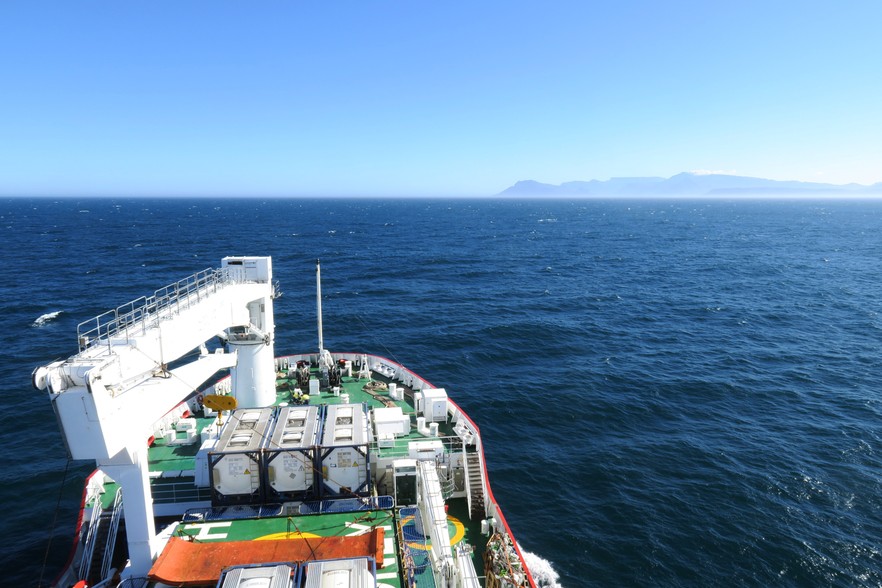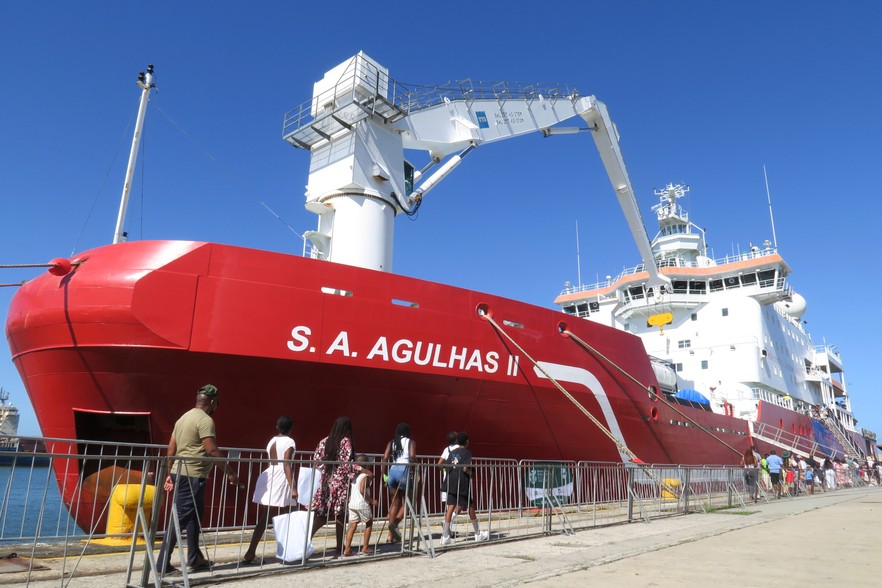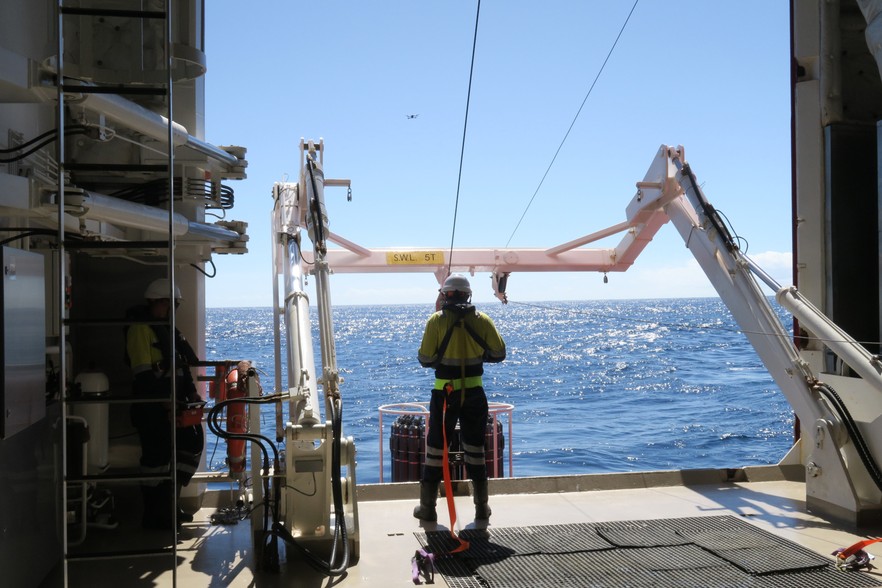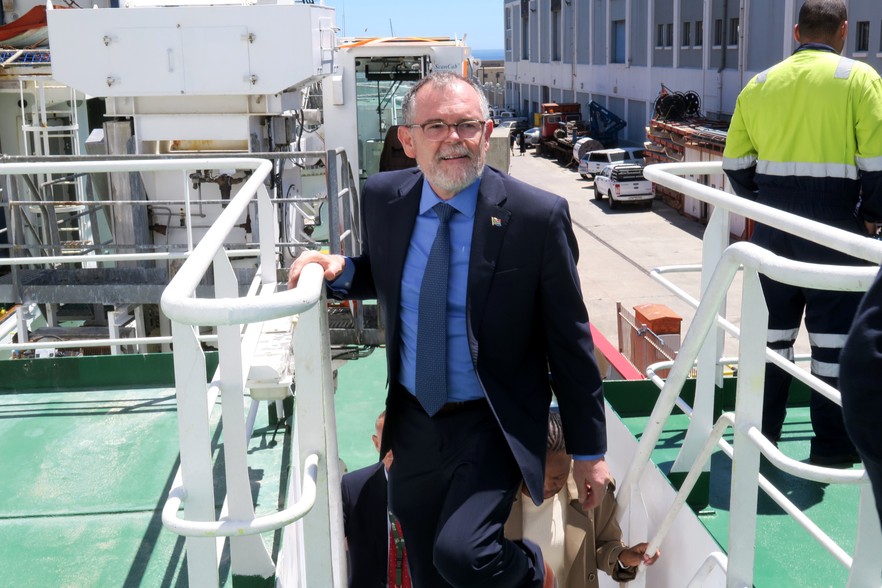Icebreaker returns from Antarctica with alarming news
Scientists aboard the SA Agulhas II have been tracking ocean health
South Africa’s world-class scientific research vessel, the SA Agulhas II, heads toward Cape Town after a stop over in East London following its annual relief and supply voyage to the SANAE IV Antarctic base. The back of Table Mountain, seen in the distance here, was a welcome sight for some researchers returning from a 12-month overwintering stay at SANAE IV, along with sobering news on the state of the southern oceans. Photos: Steve Kretzmann
- South Africa’s icebreaker ship, the SA Agulhas II, returned to Cape Town on Monday after taking supplies and a relief crew to South Africa’s Antarctic base.
- The ship had first sailed to East London where the public were invited aboard during an open day before the two-day voyage home, which media and Members of Parliament were invited to join.
- With world class research laboratories on board, researchers collect critical data from the southern ocean whenever the ship sails.
- Long-term datasets show alarming results related to accelerating climate change.
The SA Agulhas II research and Antarctic supply ship returned to Cape Town on Monday following her annual supply and relief voyage to the SA National Antarctic Expedition (SANAE) IV base, but the results the scientists on board brought back are alarming.
Since the ship was acquired at a cost of R1.3-billion in 2012, scientists on board have been gathering data on voyages to SANAE IV, and on supply and relief trips to Marion Island and Gough Island, and research expeditions up the east and west coasts of Africa.
Ashley Johnson, acting chief director of ocean and coast research, with the Department of Forestry, Fisheries and the Environment (DFFE), spoke aboard the SA Agulhas II during its voyage to Cape Town after docking in East London for a public open day on 15 February. He said data collected onboard the ship showed increasingly hotter water at the equator.
The Agulhas current transfers heat southwestwards along South Africa’s coast, and is dragging this warmer water past KwaZulu-Natal. Johnson said this warm water feeds tropical cyclones, so tropical cyclones could begin to move further south, toward central KwaZulu-Natal, affecting populations and ports such as Richards Bay and Durban, through which most of South Africa’s imports and exports go.
These tropical cyclones also cause damage to homes and businesses, and threaten life, with poor people being most vulnerable.
Research vessels such as the SA Agulhas II, along with the SA National Antarctic Programme which included the SANAE IV, Marion Island, and Gough Island bases, were essential to gain a better understanding of these ocean systems which directly affected everyone on land, said Johnson.
Nearly 4,000 people queued for hours in the sun for a tour of South Africa’s state-of-the-art scientific research vessel, the SA Agulhas II. The ship was docked in East London for a public open day after its supply and relief trip to South Africa’s SANAE IV Antarctic base.
Taking the ocean’s pulse
Much of the research conducted aboard SA Agulhas II, at SANAE IV, Marion Island, and Gough Island, is published by DFFE in its Oceans and Coasts Annual Science Report. The latest published 2023 report (the 2024 report is due in April) states that the health of the oceans is “deteriorating”.
The ocean covers 71% of the Earth’s surface and as such is the major driver and regulator of global climate, as well as being a habitat for billions of organisms. It is home to phytoplankton which produce half of the oxygen we breathe, and absorb excess carbon dioxide, while ocean currents regulate temperatures around the world.
Its deterioration, due to threats “associated with human population growth” such as overfishing, pollution, “accelerating climate change” due to an increase in greenhouse gases such as carbon dioxide, and ocean acidification, has dire implications for our long term survival.
Johnson said the southern ocean between Africa and the Antarctic was the “pulse of the world” and indicative of planetary systems health. DFFE’s focus, he said, was long-term monitoring, with Antarctic data going back to the early 1960s. He said the acceleration of climate change could not be understood without tracking over time, and if we did not understand what was happening in the ocean, we would not be able to protect it, and ourselves from accelerating climate change.
A crew member aboard the SA Agulhas II lowers a device off the side of the ship which can take water samples up to almost seven kilometres below the ocean surface. Scientists aboard the ship said microplastics are found even at these depths.
Melting ice
Johnson said South Africa — and Africa — could not simply rely on research from northern countries, as climate change would have localised impacts. An average global temperature rise of 1.5°C, which we are rapidly passing, does not mean a uniform 1.5°C rise everywhere. The Arctic, for instance, is warming faster than anywhere else on the planet at up to three times the global average. The resultant disruption of global ocean and atmospheric patterns could even result in some regions getting colder while global average temperatures rise. Researchers are concerned about melting Arctic ice causing the collapse of the Gulf Stream current which conveys warm water from the tropics to the northern latitudes. If this current – which has become alarmingly weak – stops, England and northern Europe will become significantly colder.
Average sea level rise due to melting Arctic and Antarctic ice also has different localised impacts, and is one of many phenomena we need to better understand, said Johnson.
He said if the Arctic ice on Greenland all melts, it would result in an approximate average half-metre sea level rise, but if the ice in Antarctica melts, we’d be looking at an approximate average 60 metre sea level rise.
Sea level rise contributes to storm surges which destroy coastal infrastructure, like those along the KwaZulu-Natal coast in 2007, and those in 2023, which also affected the Eastern Cape and Western Cape coasts. He said these are becoming more frequent.
“What used to be one-in-a-100-year surges are now happening every five or 15 years,” said Johnson. “Their unpredictability and size becomes more frequent. It happens again and again and again.”
Infrastructure underpinning the country’s economy, such as ports, was also vulnerable to the effects of climate change. The DFFE’s research in the southern ocean helped plan for climate change impacts.
“We are living in a world with great uncertainty in what exactly is going to happen to South Africa in respect of climate change,” he said. “Our projections are largely dependent on what ocean information we have. If we don’t have ocean data, projections will have a wide area of uncertainty.”
Forestry, Fisheries and the Environment Minister Dion George boards the SA Agulhas II when it docked in Cape Town on 17 February. George praised the scientists and crew who braved the perilous voyage, and stressed the need for the research conducted aboard the ship and at the SANAE IV base.
Conservation
DFFE Director-General Nomfundo Tshabalala, who was also aboard the SA Agulhas II from East London to Cape Town, said there was a lot of scientific data “on the land side”, but we were “low on marine studies”.
With the SA Agulhas II alone costing the DFFE about R140-million a year to operate, funding was “a challenge”, said Tshabalala.
“We are working closely with Treasury to look at other private partner funding models as it is becoming expensive to manage vessels,” she said.
She said for instance the Africana, a 42-year-old DFFE research vessel for fisheries, was in dire need of maintenance in order for her to continue “critical surveys for the fishing industry”.
But Tshabalala said her department was not just about protection and conservation. “We do want development,” she said, but “science and data” was needed so a balance between development and conservation could be found.
“We need to protect and conserve.”
The SA Agulhas II is currently moored in the Port of Cape Town, and is due to embark on a supply and relief voyage to Marion Island early in April.
Support independent journalism
Donate using Payfast

Don't miss out on the latest news
We respect your privacy, and promise we won't spam you.
Next: KZN activist shot dead
Previous: Nearly five years and R38-million later, Mamelodi families still don’t have a clinic
© 2025 GroundUp. This article is licensed under a Creative Commons Attribution-NoDerivatives 4.0 International License.
You may republish this article, so long as you credit the authors and GroundUp, and do not change the text. Please include a link back to the original article.
We put an invisible pixel in the article so that we can count traffic to republishers. All analytics tools are solely on our servers. We do not give our logs to any third party. Logs are deleted after two weeks. We do not use any IP address identifying information except to count regional traffic. We are solely interested in counting hits, not tracking users. If you republish, please do not delete the invisible pixel.




